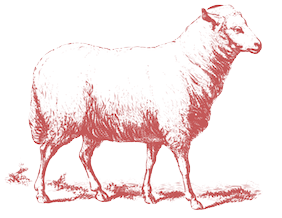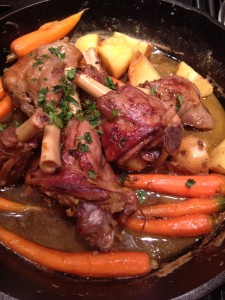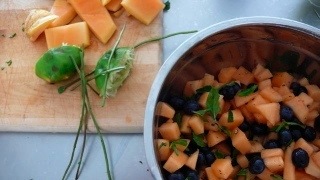When we butchered our old laying hens a couple of weeks ago, we also butchered about six roosters who had been living among the hens, fertilizing eggs and maintaining the pecking order, as it were. We butchered them last. We should have done them first when our energy was freshest. Roosters are some tough mothas! Their skin is tough to cut, requiring constant re-honing of the knives, and their cavities are impossible to open up: it took the full-strength of both my arms to pull them open enough to remove their innards. You can actually see the striations in the bands of muscle tissue, the thought of which made my jaws clench in fear of excessive mastication and the need for dental floss. To look at an old rooster carcass, one imagines a meat that has more in common with rubber bands than with actual food.
Thinking of cooking these roosters, I remembered that Chef Linton Hopkins gave a fantastic talk at the Georgia Organics conference a few years ago: he discussed the merits of the "lesser" cuts of beef, such as tongue and heart. He suggested that when cooking these meats, one has to consider what that part of the animal did in life and prepare it using the complementary characteristics. A tongue or a heart is constantly in motion, working ceaselessly chewing cud, ripping out grass, or pumping blood day and night. Thus, these cuts need a lot of long, slow cooking at a low temperature. A tenderloin, on the other hand, is a muscle that is barely used, thus it is soft and needs only the shortest amount of cooking at a very high temperature.
A chicken is no different, only, instead of specific parts, the whole body is what we are concerned with. A young chicken, hen or rooster, has not had the chance to work its muscles for very long, and so, the meat is very tender. This is why most roasting birds are slaughtered at or before 12 weeks of age. Industrially-produced chickens are butchered even sooner (and at a much higher body weight due to inhumane breeding practices and concentrate feeds laced with growth hormone).
An old farm hen or rooster, though, has lived several years: pecking, scratching, fighting, roosting, nesting. Roosters are especially active. They have to service a lot of hens, provide them with protection from other roosters and predators (yes, a rooster can fight off a hawk or a raccoon if inclined), and maintain the social order of the flock through engaging in and breaking-up fights. They are big, muscly, and tough in life, and so they are also in death.
So, how do you cook a cock? Coq au Vin, of course! This dish is quintessential French peasant food. It is designed, through long, slow cooking in wine (which is highly acidic and thereby breaks down muscle tissue) to turn an otherwise inedible rooster into something that is, frankly, succulent. It is a food borne out of the frugality of farm life. While old roosters and hens in our modern food system are sold as dog food, or processed into thin, salty canned soups, or are otherwise lost to the industrial food machine, a small farm or farm hobbyist can access a traditional staple of French cuisine that just isn't the same when you use a store-bought fryer.
In fact, when researching to find a good recipe to work from for coq au vin, I could not find one that gave instructions for actually using a "coq." They all called for a regular fryer or pieces of a fryer. As if in lament for the lack of availability of roosters, Lynne Rosetto Kasper titles her recipe for coq au vin, "Coq au Vin Nouveau!" Gentle readers, this is not coq au vin. In fact, it is everything coq au vin is not: it has a short cooking time and relies on modern conveniences such as "canned, low-sodium chicken broth", "skinless chicken thighs," and bizarrely, "white wine." Nouveau indeed!
I eventually found a recipe over at the Smitten Kitchen based off of the classic Julia Child recipe. It still called for a regular fryer, but the elements were all there: a whole bird, cut into pieces, browned with lardons, stewed in Cognac and good red wine, the sauce finished with a buerre manie, and served with browned mushrooms and caramelized pearl onions.
There, doesn't that sound better? I thought so.
I was finally able to find a recipe that actually called for a "coq" or "cockerel" in my trusty Larousse Gastronomique, which connected up with what I found at the Smitten Kitchen, only it called for a longer cooking time and to thicken the sauce not only with the buerre maine, but with the cockerel's's blood as well. I wish I had saved some!
And so, I present to you, the coq au vin that I made with a couple of old roosters in the traditional mode:
A note on ingredients: I used old roosters, but old stew hens will also work well for this. Use a young chicken or hen only if you can't find old birds. Or better yet, make a different dish suited to a more tender meat!
Please also, do not feel constrained to use the standard button mushrooms for this. I used some fantastic oyster mushrooms from our fellow farmer, Michael over at Indian Ridge Farm, who has the most amazing, large, and beautiful mushrooms I have ever seen. Many recipes call for morels (which are expensive and hard to find), but I say this is one area where you should really play with what is locally and seasonally available: chanterelles, shiitake, hen of the woods, oyster, etc. Just remember, whatever mushrooms you use, fry them in batches with lots of space between them, otherwise they won't brown.
Equipment:
A heavy, 10-inch, fireproof casserole such as cast iron or enamelware (DO NOT use nonstick), long matches, a fine, mesh strainer, parchment paper
Ingredients:
6-ounces bacon, cut into lardons
4 tablespoons butter
2 old roosters, cut into pieces
1 teaspoon salt
1/4 teaspoon pepper
1/2 cup Cognac, Armanac, or strong Brandy
6 cups (about 1.5 bottles) young, full-bodied, French red wine such as Burgundy, Beaujolais, or Cotes du Rhone
2 cups brown chicken stock or beef stock
1 tablespoon tomato paste
4 cloves mashed garlic
1 teaspoon thyme
2 bay leaves
Salt and pepper
For the buerre maine:
6 tablespoons flour
4 tablespoons softened butter
1/2 to 1 pound caramelized pearl onions
1 pound sautéed mushrooms (see note above)
Method:
In your large, flame-proof casserole, melt butter until it is hot and foaming. Add the lardons and fry slowly until browned and crisp. Set aside the lardons, but leave the hot fat in the pan. Season the rooster pieces with salt and pepper, then gently brown, letting any bits of fat and skin turn golden and slightly crisp on the edges. Pour in the Cognac and carefully light it. When the flames die down, add the wine, tomato paste, garlic, thyme, and bay leaves. Let simmer for a few minutes. Then, cover tightly with a layer of parchment paper and foil or oven-proof lid. Place in a 200 degree oven and braise for 3-4 hours (longer if you have time). After the braise is complete, remove the bits of chicken. They should be falling off the bone. Filter the juices through a fine strainer and refrigerate for a few hours, or overnight.
Meanwhile, make the buerre maine by kneading the flour and soft butter together until you have a homogeneous paste. Set aside.
Remove the layer of fat from the refrigerated sauce and heat. Whisk in your buerre maine until everything has dissolved. Reduce the sauce by about 15% , it should coat the back of a spoon nicely. Adjust seasoning.
Add the chicken back to the sauce. At this point, you can refrigerate your coq au vin for a few days before serving, if you wish.
For the accompanying mushrooms and onions (taken directly from Julia Child's Mastering the Art of French Cooking):
Oignons Glacés a Brun [Brown-braised Onions]
For 18 to 24 peeled white onions about 1 inch in diameter:
1 1/2 tablespoons butter
1 1/2 tablespoons oil
A 9- to 10-inch enameled skillet
1/2 cup of brown stock, canned beef bouillon, dry white wine, red wine or water
Salt and pepper to taste
A medium herb bouquet: 3 parsley springs, 1/2 bay leaf, and 1/4 teaspoon thyme tied in cheesecloth
When the butter and oil are bubbling the skillet, add the onions and sauté over moderate heat for about 10 minutes, rolling the onions about so they will brown as evenly as possible. Be careful not to break their skins. You cannot expect to brown them uniformly.
Pour in the liquid, season to taste, and add the herb bouquet. Cover and simmer slowly for 40 to 50 minutes until the onions are perfectly tender but retain their shape, and the liquid has evaporated. Remove the herb bouquet. Serve them as they are.
Champignons Sautés Au Buerre [Sautéed Mushrooms]
A 10-inch enameled skillet
2 tablespoons butter
1 tablespoon oil
1/2 pound fresh mushrooms, washed, well dried, left whole if small, sliced or quartered if large
1 to 2 tablespoons minced shallots or green onions (optional)
Salt and pepper
Place the skillet over high heat with the butter and oil. As soon as you see the butter foam has begun to subside, indicating that it is hot enough, add the mushrooms. Toss and shake the pan for 4 to 5 minutes. During their sauté the mushrooms will at first absorb the fat. In 2 to 3 minutes the fat will reappear on their surface, and the mushrooms will begin to brown. As soon as they have browned lightly, remove from heat.
Serve the coq au vin hot, with the mushrooms and onions scattered on top. Buttered egg noodles or boiled potatoes make an excellent and traditional accompaniment, as does a bitter green salad such as arugula, endive, or frissée.
Enjoy!



 I harvested my garden's first melon this week. It was perfect. This recipe is a bit of a mutt. It was inspired by a desert served at the CSA Members Potluck Saturday of blueberries, melon, and mint, mingled with a few ideas lifted out of Star Provisions' peach and mint salad. I was pretty pleased with the results. I know you're thinking "pepper and fruit?" but go with me here. The mint and lime make it refreshing and cool while the black pepper balances it all out by paying a kind of homage to summer's heat:
I harvested my garden's first melon this week. It was perfect. This recipe is a bit of a mutt. It was inspired by a desert served at the CSA Members Potluck Saturday of blueberries, melon, and mint, mingled with a few ideas lifted out of Star Provisions' peach and mint salad. I was pretty pleased with the results. I know you're thinking "pepper and fruit?" but go with me here. The mint and lime make it refreshing and cool while the black pepper balances it all out by paying a kind of homage to summer's heat: